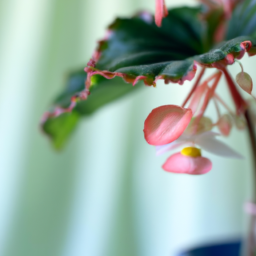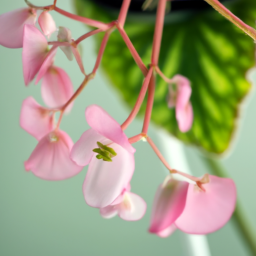
Are you looking to add some greenery to your indoor space? If so, you may want to consider adding some types of begonias indoor. Begonias are a popular choice for indoor plants due to their beautiful foliage and vibrant blooms. In this blog post, we will explore some of the different types of begonias that thrive indoors, so you can choose the perfect one for your home. Whether you’re a seasoned plant parent or just starting out, there’s a begonia variety that’s sure to suit your space and style. Let’s dive in and learn more about these stunning plants!
Popular Types of Begonias for Indoor Gardening
Introduction
When it comes to indoor gardening, begonias are a popular choice due to their beautiful foliage and vibrant flowers. There are many different types of begonias that can thrive indoors, each with its own unique characteristics and care requirements. In this guide, we will explore some of the most popular types of begonias for indoor gardening and provide tips on how to care for them.
Rex Begonias
Rex begonias are known for their stunning foliage, which comes in a variety of colors and patterns. These begonias are prized for their unique leaves, which can be silver, purple, green, or a combination of colors. Rex begonias prefer bright, indirect light and high humidity levels. They should be watered when the top inch of soil feels dry, and the leaves should be misted regularly to maintain humidity.
Another popular type of begonia for indoor gardening is the Angel Wing begonia. These begonias are named for their wing-shaped leaves, which can be green, silver, or variegated. Angel Wing begonias produce clusters of delicate flowers in shades of pink, red, or white. These begonias prefer bright, indirect light and well-draining soil. They should be watered when the top inch of soil feels dry and fertilized monthly during the growing season.
Tuberous Begonias
Tuberous begonias are prized for their large, showy flowers, which come in a wide range of colors. These begonias have tuberous roots that should be planted just below the soil surface. Tuberous begonias prefer bright, indirect light and well-draining soil. They should be watered when the top inch of soil feels dry and fertilized monthly during the growing season.
In conclusion, there are many different types of begonias that can thrive indoors, each with its own unique characteristics and care requirements. By choosing the right type of begonia for your indoor garden and providing the proper care, you can enjoy these beautiful plants year-round. Whether you prefer the stunning foliage of Rex begonias, the delicate flowers of Angel Wing begonias, or the showy blooms of tuberous begonias, there is a begonia variety to suit every indoor gardener’s taste.

Care Tips for Different Varieties of Indoor Begonias
Indoor begonias are a popular choice for houseplants due to their beautiful foliage and flowers. There are many different varieties of begonias that can thrive indoors, each with their own unique care requirements. In this guide, we will explore some of the most common types of indoor begonias and provide care tips for each variety.
Rex Begonias
Rex begonias are known for their stunning foliage, which comes in a wide range of colors and patterns. These begonias prefer bright, indirect light and should be kept away from direct sunlight, which can scorch their leaves. Keep the soil consistently moist but not waterlogged, as rex begonias are prone to root rot. They thrive in humid environments, so consider placing a humidifier near your plant or misting it regularly.
When it comes to fertilizing rex begonias, use a balanced liquid fertilizer every 4-6 weeks during the growing season. Prune any leggy or dead growth to encourage new growth and maintain a compact shape. Repot your rex begonia every 1-2 years to refresh the soil and provide more room for growth.
Common pests that can affect rex begonias include mealybugs and spider mites. Keep an eye out for any signs of infestation and treat them promptly with insecticidal soap or neem oil.
Cane Begonias
Cane begonias are prized for their tall, bamboo-like stems and clusters of delicate flowers. These begonias prefer bright, indirect light and can tolerate some direct sunlight. Water cane begonias when the top inch of soil feels dry, and be sure to provide good drainage to prevent waterlogged roots.
During the growing season, fertilize cane begonias every 4-6 weeks with a balanced liquid fertilizer. Prune back any leggy growth to promote bushier growth and remove any spent flowers to encourage continuous blooming.
Cane begonias are susceptible to powdery mildew and botrytis, especially in humid conditions. Ensure good air circulation around your plant and avoid overhead watering to prevent these fungal diseases.
Rex Begonias
Rhizomatous begonias are known for their thick, fleshy stems and colorful, textured leaves. These begonias thrive in bright, indirect light and should be kept away from direct sunlight, which can cause leaf burn. Water rhizomatous begonias when the top inch of soil feels dry, and be sure to provide good drainage to prevent root rot.
Fertilize rhizomatous begonias every 4-6 weeks during the growing season with a balanced liquid fertilizer. Prune back any leggy growth to maintain a compact shape and remove any dead or yellowing leaves to promote new growth.
Rhizomatous begonias are prone to aphids and thrips, which can damage their foliage. Keep a close eye on your plant for any signs of infestation and treat them promptly with insecticidal soap or neem oil.

Choosing the Right Begonia for Your Indoor Space
Understanding the Different Types of Begonias
When it comes to choosing the right begonia for your indoor space, it’s important to understand the different types available. Begonias come in a variety of shapes, sizes, and colors, making them a versatile option for indoor gardening. Some popular types of begonias include rex begonias, cane begonias, and tuberous begonias.
Rex begonias are known for their unique foliage, which often features intricate patterns and vibrant colors. These begonias are a great choice for adding a pop of color to your indoor space. Cane begonias, on the other hand, are known for their tall, cane-like stems and clusters of flowers. These begonias are perfect for adding some height to your indoor garden. Tuberous begonias are prized for their showy flowers, which come in a wide range of colors. These begonias are a great choice for adding a touch of elegance to your indoor space.
When choosing a begonia for your indoor space, consider the lighting conditions in your home. Rex begonias prefer bright, indirect light, while cane begonias can tolerate lower light levels. Tuberous begonias thrive in bright, indirect light, but can also tolerate some direct sunlight. By choosing a begonia that matches the lighting conditions in your home, you can ensure that your plant will thrive.
Tips for Caring for Indoor Begonias
Once you’ve chosen the right begonia for your indoor space, it’s important to provide the proper care to help your plant thrive. Begonias require regular watering, but it’s important to avoid overwatering, as this can lead to root rot. Allow the top inch of soil to dry out between waterings, and be sure to water your begonia at the base of the plant to prevent the foliage from getting wet.
In addition to regular watering, begonias also benefit from regular fertilization. Use a balanced, water-soluble fertilizer every 4-6 weeks during the growing season to help promote healthy growth and blooming. Be sure to follow the instructions on the fertilizer package to avoid over-fertilizing your plant.
Finally, be sure to provide your begonia with the right growing conditions. Most begonias prefer temperatures between 60-75 degrees Fahrenheit, so be sure to keep your indoor space within this range. Additionally, be sure to provide your begonia with adequate humidity, as dry air can cause the foliage to dry out and wilt.
Common Pests and Diseases to Watch Out For
While begonias are relatively low-maintenance plants, they can be susceptible to pests and diseases if not properly cared for. Some common pests to watch out for include spider mites, aphids, and mealybugs. These pests can cause damage to the foliage and flowers of your begonia, so it’s important to take action at the first sign of infestation.
To prevent pests, be sure to inspect your begonia regularly for any signs of infestation. If you do notice pests, you can try using insecticidal soap or neem oil to help control the population. Be sure to follow the instructions on the product label to ensure safe and effective treatment.
In addition to pests, begonias can also be prone to diseases such as powdery mildew and botrytis. To prevent these diseases, be sure to provide your begonia with adequate air circulation and avoid overhead watering. If you do notice signs of disease, be sure to remove and dispose of any affected foliage to prevent the spread of the disease.
By choosing the right begonia for your indoor space and providing the proper care, you can enjoy the beauty of these versatile plants in your home. With a little bit of attention and care, your indoor begonia can thrive and brighten up your living space.
Let’s wrap up what we learned
If you’re looking to add some vibrant and colorful plants to your indoor space, begonias are a fantastic option to consider. With their unique foliage and stunning blooms, begonias come in a variety of types that can thrive indoors. One popular type is the Rex begonia, known for its striking leaves with intricate patterns and colors. These begonias prefer indirect light and high humidity, making them perfect for bathrooms or kitchens.
Another popular indoor begonia is the Angel Wing begonia, named for its wing-shaped leaves. These begonias produce clusters of delicate flowers and are easy to care for, requiring bright, indirect light and regular watering. For a more compact option, the Rieger begonia is a great choice, with its compact growth habit and colorful blooms that can brighten up any room. No matter which type of begonia you choose, these plants are sure to add beauty and charm to your indoor space.
Common Questions and Answers:
Q1: What are the different types of begonias that can be grown indoors?
A1: There are several types of begonias that thrive indoors, including Rex begonias, Angel wing begonias, and Tuberous begonias.
Q2: Are begonias easy to care for indoors?
A2: Begonias are relatively easy to care for indoors as long as they receive the right amount of light, water, and humidity. They prefer bright, indirect light and well-draining soil.
Q3: How often should I water indoor begonias?
A3: Indoor begonias should be watered when the top inch of soil feels dry to the touch. It’s important not to overwater them, as they are prone to root rot.
Q4: Can indoor begonias be grown in pots or hanging baskets?
A4: Yes, indoor begonias can be grown in pots or hanging baskets, depending on the type of begonia. Hanging baskets are a popular choice for trailing varieties like Angel wing begonias.
Q5: Do indoor begonias require any special care during the winter months?
A5: During the winter months, indoor begonias may benefit from slightly lower temperatures and reduced watering. It’s important to keep them away from drafts and heaters to prevent stress on the plants.
Dr. Olivia Green is a botanist with over two decades of experience in indoor plant cultivation. She holds a Ph.D. in Plant Biology and has dedicated her career to researching plant behavior in controlled environments. Dr. Green is passionate about helping plant enthusiasts master the art of indoor gardening through her extensive knowledge and practical insights.


